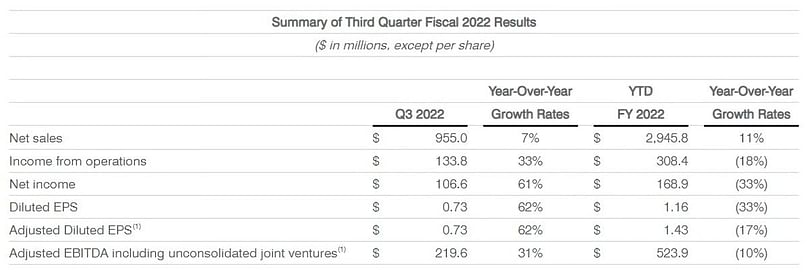主标签
Lamb Weston Reports Fiscal Third Quarter 2022 Results; Updates Fiscal Year 2022 Outlook

Lamb Weston Reports Fiscal Third Quarter 2022 Results; Updates Fiscal Year 2022 Outlook
Lamb Weston Holdings, Inc. (NYSE: LW) announced its fiscal third-quarter 2022 results and updated its fiscal 2022 outlook.
Tom Werner, President, and CEO:
"We continued to make financial and operating progress in the quarter through strong execution of pricing actions to manage significant input, manufacturing, and supply chain cost inflation."Q3 2022 Commentary
"Our pricing actions, along with manufacturing productivity and cost mitigation efforts, drove sequential and year-over-year improvement in our gross margin despite the Omicron variant affecting demand across our restaurant and foodservice channels and disrupting production and distribution operations more than we anticipated. In addition, constraints in global logistics networks continued to significantly limit our international sales volumes."
"We are managing through this challenging macro environment well and remain on track to deliver our financial targets for fiscal 2022. The increase in our potato costs resulting from the exceptionally poor crop harvested in fall 2021 in the Pacific Northwest is in line with expectations, and we have secured enough raw potatoes to meet our near-term production forecast."
"We plan to continue to execute on our pricing, productivity and cost management actions to mitigate the effect of inflation, and drive run-rate and throughput improvements in our factories."
"Our capacity expansions in Idaho and China are on schedule, and we remain confident that continuing to invest in our business and executing our strategies will have us well-positioned to support the needs of customers and drive long-term growth."
Net sales increased USD 59.2 million to USD 955.0 million, up 7 percent versus the prior-year quarter. Price/mix increased 12 percent, primarily reflecting the benefit of pricing actions across each of the Company’s business segments to offset input, manufacturing, and transportation cost inflation. Volume declined 5 percent, reflecting lower export volume and lower shipments to retail channels.
The Company increased shipments to restaurant and foodservice channels in North America, although growth was tempered by softer restaurant traffic as a result of the effects of the Omicron variant of the COVID-19 virus and an inability to fully serve customer demand due to widespread industry supply chain constraints, including labor and commodities shortages, that resulted in lower production run-rates and throughput in the factories.
Income from operations increased USD 33.2 million to USD 133.8 million, up 33 percent versus the prior-year quarter, reflecting higher gross profit and lower selling, general and administrative expenses ("SG&A"). Gross profit increased USD 24.3 million, as the benefits from higher price/mix more than offset the impact of higher manufacturing and distribution costs on a per pound basis, as well as lower sales volumes.
The higher costs per pound primarily reflected double-digit cost inflation from key inputs, particularly raw materials such as edible oils, ingredients such as grains and starches used in product coatings, and raw potatoes, as well as higher transportation, packaging, and labor costs.
The increase in costs per pound also reflected the effects of labor and commodities shortages on production run-rates, as well as lower raw potato utilization rates.
The increase in per-pound costs was partially offset by supply chain productivity savings. The increase in gross profit also included a USD 1.7 million increase in unrealized mark-to-market adjustments associated with commodity hedging contracts, which includes a USD 3.6 million gain in the current quarter, compared with a USD 1.9 million gain related to these items in the prior-year quarter.
SG&A declined USD 8.9 million compared to the prior-year quarter, primarily due to lower consulting expenses associated with improving the Company’s commercial and supply chain operations, lower compensation, and benefits expenses, and a USD 1.9 million decrease in advertising and promotion expenses ("A&P").
The decrease in SG&A was partially offset by higher information technology infrastructure costs, including expenses related to the planning and design of the Company’s new enterprise resource planning ("ERP") system, as well as unfavorable foreign exchange expenses.
Approximately USD 2 million of the ERP-related expenses recognized in the quarter consisted primarily of consulting expenses that will not continue after the Company implements its new ERP system, compared to approximately USD 1 million of ERP-related expenses in the prior-year quarter.
Net income was USD 106.6 million, up USD 40.5 million versus the prior-year quarter, and Diluted EPS was USD 0.73, up USD 0.28 versus the prior-year quarter. The increases were driven by higher income from operations and equity method investment earnings.
Adjusted EBITDA including unconsolidated joint ventures(1) increased USD 52.5 million to USD 219.6 million, up 31 percent versus the prior-year quarter, driven by higher income from operations and equity method investment earnings.
The Company’s effective tax rate(2) in the third fiscal quarter was 22.6 percent, versus 19.8 percent in the prior-year quarter. The Company’s effective tax rate varies from the U.S. statutory tax rate of 21 percent principally due to the impact of U.S. state taxes, foreign taxes, permanent differences, and discrete items.
Q3 2022 Segment Highlights
Global
Net sales for the Global segment, which is generally comprised of the top 100 North American based quick service (“QSR”) and full-service restaurant chain customers as well as all of the Company’s international sales, increased USD 9.4 million to USD 487.9 million, up 2 percent versus the prior-year quarter, with price/mix up 8 percent and volume down 6 percent.
The benefit of domestic and international product and freight pricing actions to offset inflation, as well as a favorable mix, drove the increase in price/mix. Lower export shipments due to limited shipping container availability and disruptions to ocean freight networks drove the decline in sales volumes.
Sales volumes to North American large QSR and casual dining restaurant chain customers increased, although this increase was tempered by softer consumer traffic as a result of the effects of the Omicron variant.
Global segment product contribution margin declined USD 6.3 million to USD 73.0 million, down 8 percent versus the prior-year quarter. Higher manufacturing and distribution costs per pound, as well as lower sales volumes, more than offset the benefit of favorable price/mix.
Foodservice
Net sales for the Foodservice segment, which services North American foodservice distributors and restaurant chains generally outside the top 100 North American based restaurant chain customers, increased USD 75.0 million to USD 294.5 million, up 34 percent versus the prior-year quarter, with price/mix up 22 percent and volume up 12 percent.
The benefits of product and freight pricing actions taken earlier in the year to offset inflation, as well as favorable mix, drove the increase in price/mix. The ongoing recovery in demand at full-service restaurants and in non-commercial channels (such as lodging and hospitality, healthcare, schools and universities, sports and entertainment, and workplace environments) drove the increase in sales volumes.
While shipments to restaurants have essentially returned to pre-pandemic levels, demand in non-commercial channels remains below pre-pandemic levels.
The segment’s overall volume growth was tempered by softer restaurant and non-commercial traffic as a result of the effects of the Omicron variant, as well as an inability to fully serve customer demand due to widespread industry supply chain constraints, including labor shortages, that resulted in lower production run-rates and throughput in the factories.
Foodservice segment's product contribution margin increased USD 36.5 million to USD 106.7 million, up 52 percent compared to the prior-year quarter. Favorable price, volume, and mix drove the increase and were partially offset by higher manufacturing and distribution costs per pound.
Retail
Net sales for the Retail segment, which includes sales of branded and private label products to grocery, mass merchant, and club customers in North America, declined USD 18.9 million to USD 143.6 million, down 12 percent versus the prior-year quarter, with volume down 24 percent and price/mix up 12 percent.
Lower shipments of private label products, resulting from incremental losses of certain low-margin business, as well as lower shipments of branded products, drove the sales volume decline. The decline in branded product shipments reflected an inability to fully serve customer demand due to lower production run-rates and throughput in the factories.
Product and freight pricing actions across the branded and private label portfolios to offset inflation, as well as improved mix, drove the increase in price/mix.
Retail segment product contribution margin declined USD 1.5 million to USD 31.6 million, down 5 percent versus the prior-year quarter. Lower sales volumes and higher manufacturing and distribution costs per pound drove the decline, partially offset by favorable price/mix and a USD 1.6 million decrease in A&P expenses.
Equity Method Investment Earnings
Equity method investment earnings from unconsolidated joint ventures in Europe, the U.S., and South America were USD 29.7 million and USD 11.1 million for the third quarter of fiscal 2022 and 2021, respectively.
Equity method investment earnings included a USD 19.6 million unrealized gain related to mark-to-market adjustments associated with currency and commodity hedging contracts in the current quarter, compared to a USD 2.2 million unrealized gain related to these items in the prior-year quarter.
The increase in mark-to-market adjustments in the third quarter of fiscal 2022, primarily relates to changes in the value of natural gas derivatives at Lamb-Weston/Meijer as commodity markets in Europe have experienced significant volatility.
Excluding the mark-to-market adjustments, earnings from equity method investments increased USD 1.2 million compared to the prior-year quarter. The increase reflects the benefit of favorable price/mix and higher sales volumes, largely offset by input cost inflation and higher manufacturing and distribution costs in both Europe and the U.S.
Cash Flow and Liquidity
In the first three quarters of fiscal 2022, net cash from operating activities was USD 174.0 million, down USD 200.8 million versus the prior-year period, primarily due to unfavorable changes in working capital and lower earnings.
Capital expenditures, including information technology expenditures, were USD 227.0 million, up USD 120.3 million versus the prior-year period, reflecting increased investments to support capacity expansion projects.
At the end of the third quarter of fiscal 2022, the Company had USD 428.6 million of cash and cash equivalents and no borrowings outstanding under its USD 1.0 billion revolving credit facility.
Capital Returned to Shareholders
In the third quarter of fiscal 2022, the Company returned a total of USD 84.3 million to shareholders, including USD 34.3 million in cash dividends and USD 50.0 million through share repurchases. The Company repurchased 763,777 shares during the quarter at an average price per share of USD 65.46.
Fiscal 2022 Outlook
The Company continues to expect fiscal 2022 net sales growth will be above its long-term target of low-to-mid single digits. The Company anticipates net sales growth in the fourth quarter of fiscal 2022 will be driven largely by price/mix, reflecting the Company’s pricing actions to offset input and transportation cost inflation.
The Company expects net income and Adjusted EBITDA including unconsolidated joint ventures(1) in the fourth quarter of fiscal 2022 will continue to be pressured, as it manages through significant inflation for key production inputs, transportation, and packaging, as well as industrywide operational challenges, including labor and commodities shortages, resulting from volatility in the broader supply chain.
In addition, the Company expects higher raw potato costs on a per pound basis due to the impact of extreme summer heat that negatively affected the yield and quality of potato crops in the Pacific Northwest. Taking these headwinds into account, the Company expects its full-year fiscal 2022 gross margin to be 19 percent to 20 percent. The Company previously expected its full-year fiscal 2022 gross margin to be 18 percent to 20 percent.
For the fourth quarter of fiscal 2022, the Company is targeting a gross margin of 19 percent to 21 percent. In addition, the Company expects that ongoing investments in information technology, including the second phase of its ERP project, will increase SG&A expenses as compared to the fourth quarter of fiscal 2021.
The Company expects that these investments will improve its ability to support growth and margin improvement over the long term.
In addition, for fiscal 2022, the Company continues to expect:
- Depreciation and amortization of approximately USD 190 million,
- Interest expense of approximately USD163 million, which includes a USD 53.3 million loss (an aggregate call premium of USD 39.6 million of cash and a write-off of USD 13.7 million of previously unamortized debt issuance costs associated with the redeemed senior notes) on the extinguishment of debt that the Company recognized during the second quarter of fiscal 2022, and
- Effective tax rate of approximately 22 percent.
The Company reduced its estimate for cash used for capital expenditures, excluding acquisitions, to approximately USD 325 million from its previous estimate of USD 450 million, due to the projected timing of expenditures related to certain capacity expansion projects.
End Notes
(1) Adjusted Diluted EPS and Adjusted EBITDA including unconsolidated joint ventures are non-GAAP financial measures. Please see the discussion of non-GAAP financial measures and the associated reconciliations at the end of this press release for more information.
(2)The effective tax rate is calculated as the ratio of income tax expense to pre-tax income, inclusive of equity method investment earnings.
(3)For more information about product contribution margin, please see “Non-GAAP Financial Measures” and the table titled “Segment Information” included in this press release.
Like to receive news like this by email? Join and Subscribe!
Get the latest potato industry news straight to your WhatsApp. Join the PotatoPro WhatsApp Community!
精选企业
Sponsored Content
Sponsored Content
Sponsored Content
Sponsored Content













